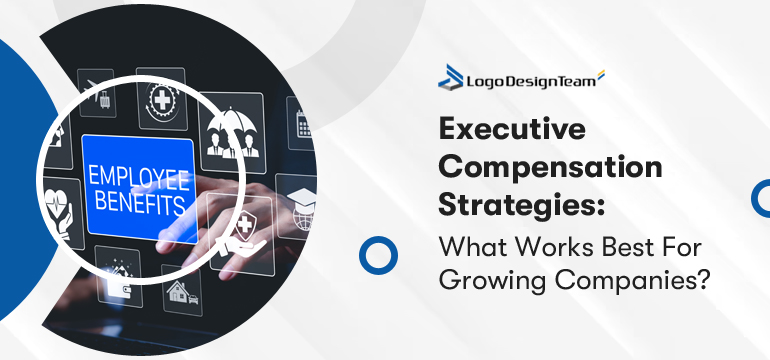The quality of executive talent is a critical factor for the success of growing companies. To achieve sustainable growth, companies must implement executive compensation strategies that not only draw in senior executives but also motivate them to align their efforts with the company’s broader goals. An effective executive compensation plan can be the difference between survival and success.

Read on to learn how you can be strategic in designing your executive compensation plans in a way that boosts your growing company.
The Importance of Tailored Executive Compensation Strategies
A generic, one-size-fits-all approach to executive compensation may not meet the distinct needs of both the company and its senior leadership. According to CEO of JER HR Group, a leading human resource firm operating in over 35 states across the country, aligning executive compensation plans with a company’s unique vision and strategic goals is essential for sustainable growth.
Here are the key reasons why customized executive compensation strategies matter:
1. Alignment with Company Vision and Strategy
Custom compensation plans ensure that executive goals are aligned with the company’s broader vision and long-term objectives. This alignment motivates executives to drive growth, innovation, and initiatives that directly contribute to the company’s success.
2. Attracting Top Executive Talent
Tailored compensation packages allow companies to offer competitive and appealing benefits that meet the expectations of top candidates. In a competitive job market, these customized plans can be the deciding factor that draws in highly qualified executives capable of steering the company toward its goals.
3. Retention of Key Executives
High executive turnover can hinder progress and disrupt a company’s trajectory. Custom compensation plans help foster loyalty and mitigate the risk of attrition by addressing executives’ unique needs and career aspirations. Long-term incentives, such as equity compensation and deferred compensation plans, play a vital role in retaining top talent.
4. Motivation and Performance Enhancement
Tailored plans that integrate performance-based incentives, like annual bonuses and long-term incentive plans (LTIPs), keep executives motivated to achieve defined performance targets. Tying compensation to key performance indicators (KPIs) ensures individual efforts align with company success, cultivating a high-performance culture.
5. Flexibility to Adapt to Market Trends
Tailored compensation strategies enable organizations to adapt swiftly to fluctuations in market dynamics and industry developments. This adaptability is essential for sustaining a competitive advantage and ensuring that compensation frameworks align with contemporary best practices, including the integration of equity-based incentives and performance-related pay. By using marketing outsourcing into the equation, organizations can redirect internal focus toward strategic initiatives while ensuring their external messaging resonates with market trends, creating a seamless link between performance incentives and market-driven outcomes.
6. Promoting Long-Term Value Creation
Tailor-made strategies include long-term incentives like stock options, restricted stock units
(RSUs), and performance shares, which encourage executives to focus on sustained growth and shareholder value. This helps shift focus from short-term gains to long-term, strategic achievements.
7. Incorporation of Unique Business Goals
Each company has distinct goals and challenges. Tailored executive compensation plans take these into account, ensuring that compensation structures reflect the company’s strategic priorities, whether it’s driving revenue growth, expanding into new markets, or enhancing operational efficiency.
8. Building Shareholder Confidence
When compensation plans are closely tied to company performance and executive outcomes, shareholder confidence in the leadership team strengthens. Clear compensation disclosure and alignment with total shareholder return promote transparency and trust among investors.
Implementing tailored executive compensation strategies helps companies align executive performance with their long-term business objectives, appeal to and keep top talent, and foster a culture of high performance and loyalty. This strategic approach ensures compensation packages are competitive and effective in driving sustainable growth and enhancing shareholder value.
Structuring Executive Compensation Plans for Growth
Structuring executive compensation plans for growth requires a strategic approach that balances immediate rewards with long-term value creation. For a growing company, the ideal compensation structure blends various elements that motivate senior executives and align their efforts with company objectives. Below are the critical aspects of an effective executive compensation structure:
1. Base Salary
This is the foundational component of an executive’s pay and is essential for attracting top talent. While competitive, it should be balanced with performance-based elements to ensure executives are incentivized to contribute beyond their primary duties.
2. Annual Bonuses
These short-term incentives are designed to reward executives for achieving specific financial or operational targets within a given year. Tied closely to company performance and individual KPIs, annual bonuses help keep executives focused on meeting short-term business goals.
3. Equity Compensation
Offering equity compensation such as stock options, RSUs, or performance shares allows executives to have a direct stake in the company’s success. This element not only aligns their interests with shareholders but also fosters long-term commitment and retention.
4. Long-Term Incentive Plans (LTIPs)
LTIPs are designed to incentivize executives to meet extended performance goals that contribute to sustainable company growth. These plans often include stock awards or performance shares that vest over multiple years based on achieving long-term objectives.
5. Nonqualified Deferred Compensation
This is an attractive component for senior executives who want to defer a portion of their income to a later date. It provides potential tax advantages and additional savings options beyond traditional retirement plans.
6. Retirement Plans
Comprehensive retirement benefits, such as 401(k) matching or executive pension plans, are essential for retaining senior executives and ensuring their long-term financial security.
7. Fringe Benefits and Executive Perks
Supplemental benefits such as health insurance, car allowances, or club memberships can add value to a compensation package and enhance job satisfaction.
8. Performance-Based Pay
This includes compensation tied to the achievement of specific metrics such as revenue growth, total shareholder return, or other key performance indicators. It ensures executives are rewarded proportionally for contributing to company success.
9. Clawback Provisions
Many companies include clawback clauses in their compensation plans to safeguard against financial misreporting or policy breaches. These clauses allow the recovery of bonuses or incentives under certain conditions.
10. Deferred Compensation and Stock Options
Including deferred compensation plans and stock options helps align the executive’s interests with the company’s long-term stock price performance. Stock options often come with a strike price and vesting schedule, which motivate executives to drive company growth over time.
11. Annual and Term Incentives
These incentives ensure that executives are consistently working toward annual and longer-term objectives. Such incentives can be linked to a mix of business goals that drive growth and innovation.
By carefully structuring these elements, companies can create comprehensive compensation plans that attract top executive talent, foster loyalty, and align leadership efforts with both short-term achievements and long-term strategic goals.

Evaluating the Effectiveness of Your Executive Compensation Plan
To determine if your current executive compensation plan or strategy is working effectively or needs improvement, you should assess it using the following key indicators and methods:
1. Alignment with Business Goals
Evaluate whether your executive compensation strategy aligns with the company’s business objectives. An effective plan should incentivize senior leaders to achieve specific, measurable outcomes that contribute to long-term growth and success.
2. Executive Performance and Retention
Track executive performance and retention rates. If your strategy is working, you should see strong performance from your executives and a low turnover rate. High turnover or underperformance could indicate that your compensation plan isn’t effectively motivating or retaining talent.
3. Company Performance Metrics
Review company performance indicators such as revenue growth, profitability, shareholder value, and total shareholder return. If these metrics align with the performance goals outlined in the compensation plan, it’s a good sign that the strategy is effective.
4. Benchmarking Against Industry Standards
Compare your executive compensation plan to those of similar companies within your industry. If your plan is competitive, it should be aligned with market trends and compensation surveys. Significant discrepancies suggest your plan needs adjustments to remain competitive and attract top talent.
5. Feedback from Executives
Solicit feedback directly from your executives about their compensation package. Their input can provide insights into whether they feel appropriately incentivized and satisfied with the structure of their compensation.
6. Analysis of Incentive Effectiveness
Assess whether the incentives within your compensation strategy are driving the desired behaviors. For example, if your plan includes performance-based bonuses or equity compensation, analyze if these are effectively motivating executives to reach key performance indicators and broader business goals.
7. Turnover and Exit Interviews
Conduct exit interviews with departing executives to understand if compensation played a role in their decision to leave. High turnover attributed to dissatisfaction with compensation is a clear sign that the strategy needs improvement.
8. Compensation Plan Complexity
Examine the complexity of your current plan. If the pay structure is too complex or unclear, it may fail to motivate executives appropriately. Simplifying the plan or clarifying how incentives align with performance metrics can enhance its effectiveness.
9. Feedback from Compensation Committees
Consult with your compensation committee or external compensation consulting firms for a thorough review of your current plan. They can offer expert insights and recommend modifications based on trends, compliance requirements, and best practices.
10. Employee Morale and Shareholder Sentiment
Consider the overall morale of your workforce and the sentiment among shareholders. A successful executive compensation strategy can foster trust and confidence among both employees and investors.
Through a thorough assessment of these aspects, you can ascertain whether your executive compensation plan is operating efficiently or needs enhancement to more effectively align with organizational objectives, attract and retain high-caliber talent, and promote sustained success.
Conclusion
Crafting effective executive compensation strategies is vital for any company’s growth and success. Ensuring alignment between compensation packages and company goals not only drives executive performance but also enhances shareholder value and supports sustainable company growth. Ultimately, a well-designed executive compensation plan motivates leaders, aligns their efforts with business strategy, and lays the foundation for long-term success and stability.




